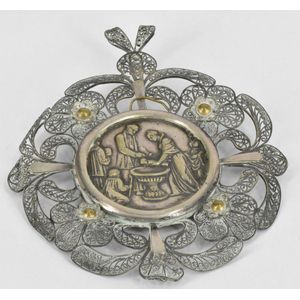George IV Silver Toast Rack with Acanthus Decoration
You must be a subscriber, and be logged in to view price and dealer details.
Subscribe Now to view actual auction price for this item
When you subscribe, you have the option of setting the currency in which to display prices to $Au, $US, $NZ or Stg.
- George Iv - George IV (1762 ? 1830) was king of the United Kingdom of Great Britain and Ireland and king of Hanover from 1820, until his own death in 1830. From 1811 until his accession in 1820, he served as Prince Regent during his father's final mental illness.
In English furniture design, his reign from 1811 to 1830 is known as the Regency period. - Circa - A Latin term meaning 'about', often used in the antique trade to give an approximate date for the piece, usually considered to be five years on either side of the circa year. Thus, circa 1900 means the piece was made about 1900, probably between 1895 and 1905. The expression is sometimes abbreviated to c.1900.
- Lion's Paw - The decorative lion's paw has been used in furniture, silver, and ceramics for centuries. It is a stylized representation of the paw of a lion, often depicted in a highly realistic or stylized form.
In furniture design, lion's paws were popular in the neoclassical and Empire styles of the late 18th and early 19th centuries. They were often used as feet on tables, chairs, and other pieces of furniture. The lion's paw was a popular motif for furniture makers because it added a sense of grandeur and regalness to their pieces.
In silverware design, the lion's paw was often used on the feet of tea and coffee pots, as well as on other pieces of silverware such as wine coolers and tureens. The lion's paw was often used in combination with other neoclassical motifs, such as acanthus leaves or grape clusters, to create a sense of grandeur and classical elegance.
In ceramics, lion's paws were commonly used as feet on vases, urns, and other pottery items. The lion's paw was often depicted in relief or as a highly stylized form, and was sometimes used in combination with other decorative elements, such as garlands or swags. - Acanthus - A stylized leaf motif, one of the primary decorative elements of classical Greek and Roman architecture, derived from the genus of flowering plants in the family Acanthaceae, native to tropical and subtropical regions of the Mediterranean area. It is a common element in classical Greek and Roman design, and is often seen in Corinthian and Composite order columns and used as a decorative element in English, European and Australian furniture, particularly on the curve of a leg, and as decoration for a corbel.
- Sterling Silver - Sterling silver is a mixture of 92.5% pure silver and 7.5% of another metal, usually copper. Fine silver is 99.9% pure silver, and is relatively soft and the addition of the very small amount of copper gives the metal enough strength and hardness to be worked into jewellery, decorative and household objects.
This item has been included into following indexes:
Visually similar items

A pair of vintage South Sea pearl and diamond earrings, 650 platinum, presented as short fixed drop panels, each set with a single round white South Sea pearl measuring 13.2 mm with fine lustre, surmounted by a fixed trapeze shaped panel of pierced wire wo

A Christening icon, silver and metal frame. Diameter 90 mm

An English sterling silver buckle, Birmingham, 1908, with a curved pierced filigree pattern. Wt 30 grams

A sterling silver Openwork comport, miniature comport with scrolls and foliate deisgn, raised on one circular food. Martin, hall & Co, Birmingham 1904. Diameter 10 cm. Height 4 cm. Weight 58.5g.
